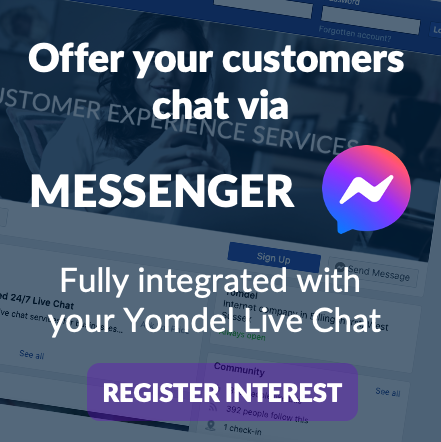In the first part of this series of blogs, which explains how you should go about structuring a test plan for your live chat service – How to test your live chat service: Part 1 - Getting started – I outlined the importance of testing when setting up and running a live chat service for your website.
In order to put this into perspective I also highlighted the goals that Yomdel strives to achieve, and that therefore drive Yomdel’s test plan and processes.
Defining your goals is essential, and is the first of our five key steps to writing a test plan:
1. Goals – what you want to achieve
2. Coverage – what you’ll need to test (in order to meet those goals)
3. Information requirements – what you need to gather (in order to get the coverage you need)
4. Resources – what resources you need (to gather the required information)
5. Processes – a bit more detail on how it’s going to be managed (so you have something to go on your business action plan)
That really should give you a good outline for your test plan. And if you follow those steps, you’ll find yourself moving from not knowing what you need, to not only knowing it, but to having an understanding of the specific steps you’ll need to take in order to get you to where you want to be in no time at all.
In this blog – part 2 in the series – I will provide some thoughts about how to scope out the test coverage for your plan ie specifically what you will need to test in order to achieve your test goals.
To strike the right balance between ensuring good test coverage and keeping the test process simple/ manageable, at Yomdel we test 10 variables. These are explained below.
1. Location of chat button/ image/ text
If you've visited websites that offer live chat you’ll have noticed a multitude of places that a live chat button or window can be placed. It stands to reason then, that in order to ensure live chat is working as hard it can be on your website, you’ll need to try out different options, monitor results and see what works best for your audience.
You may find that different locations work well on different pages and/or at different times. More likely though - you’ll find that your customers seek consistency, especially if most of your business comes from repeat visitors.
2. Design of chat button/ image/ text
How the live chat service on your website is designed will have an impact on how many of your customers will use it? What do you want your customers to think when they see your live chat service? Would they rather talk to a male or female operator? Does it matter? Should the operator be human at all? What products and services do you sell? What are your brand values? Does your live chat align with the brand? Does it blend with your website? And if so, can your customers see it?
3. Chat interface end-user experience
Chat interfaces are fairly standard. The customer types a question and the operator types a response. A discussion follows. The operator asks the customer for feedback. The customer rates the chat. The customer can ask that a transcript of the chat is emailed to them. The technology is well established and software developers know what works.
That shouldn't stop you from analysing and testing though. Do your customers want to be known by name? Do they want to give you an email address upfront in case of technical problems interrupting the chat? Or would they find this obtrusive?
4. Proactive chat invite effectiveness
Proactive chat – where an operator invites a customer to chat - if done right, can significantly increase your conversion rates. If done wrong however, it can be irritating - turning customers away from your website – sending them to a competitor instead. So it’s very important to get it right.
Yomdel’s live chat software offers you the ability to establish a set of rules that trigger a proactive chat invite when your visitors are behaving in ways that – due to analysis of historical data – you know is an indication of them being stuck, unsure of something, or about to leave the website or abandon a purchase.
It also gives you the ability to design your chat invites according to different rule sets, and if you want to, different users or audiences. This helps you to ensure you get the right invite message to the right user at the right time.
5. Operator efficiency
The efficiency of your operators is key to the success of live chat on your website. How quickly can they respond to questions? How good are they at coping with more than one simultaneous chat? The only way to find out is to test them, provide feedback and then test them again.
6. Operator language skills
Will your operators need to deal with customers who do not speak their native tongue as a first language? If so, are they trained to do so? If not, what are you going to do about it? If so, you need to test, monitor and improve on a continuous basis. Language is not an issue until it becomes a problem. And if your customer feels like the operator doesn't understand them – the usefulness of the chat is undermined.
7. Operator product knowledge
Since a lot of questions that customers ask will be related to your products, it’s important that your operators are knowledgeable about your products. At Yomdel this is a question that we are asked frequently – “how will your operators cope with questions about my products?”
The answer is we test them and train them until they are experts. We start with a set of FAQs which are provided by the client and then we run infinite scenarios past the operators to find knowledge gaps. From this we develop a knowledge base that operators can use to fill those gaps. The knowledge base then becomes a tool that Yomdel’s operators and the client use to ensure that any questions do not remain unanswered and that new product information is communicated immediately.
8. Operator professionalism
As is the case in any interaction you have with a customer, you’ll want to ensure you are acting professionally in your live chat situations. You’ll need to ensure your operators are using good grammar and not making spelling mistakes. Check that you have access to all your transcripts so that you can monitor your chats. If the volume is too high for you to read through each and every chat, do spot checks and be ready to act fast if the number of imperfections exceeds your agreed tolerance rate.
9. End-user common questions
End user common questions are really important. From these you can gain insight into, not only what information you need to ensure your operators know, but also into where there might be issues that you didn't previously realise you had with regards to the information on your website, or issues with other aspects of your product or your business. Capture this information quickly and use it to improve your service in all relevant areas.
10. End-user satisfaction
Last but not least, end user satisfaction is important because it tells you – quite simply - whether your chat is working or not. There are many ways that you can measure user satisfaction – and these will be explored in the next part of the series – but most chat software providers offer you the capability to include post-chat surveys and rating features within the chat window.
So, those are the areas that we consider important when thinking about test coverage at Yomdel. Tell us if you think there are other areas that should be included.
In the next part of this blog series I’ll be looking into information requirements. Specifically, I’ll be answering the question of what information is needed in order to achieve the test coverage outlined here. I hope you find it useful. You can subscribe for our RSS or connect with us on our social pages using the icons on the top right.







